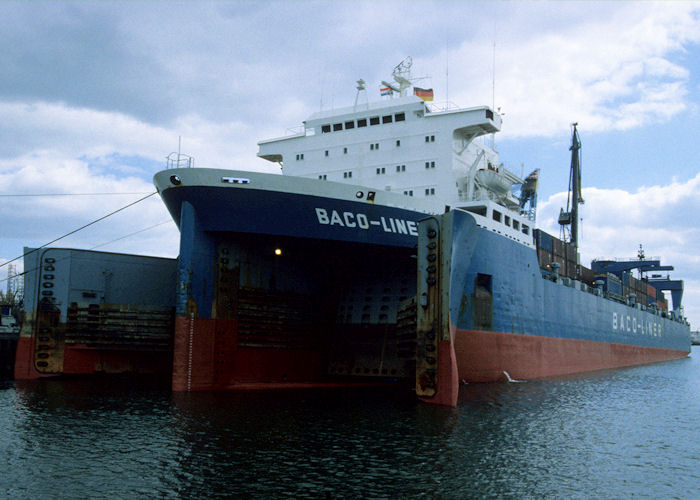Baco-Liner
The Baco -Liner 2 in Hamburg Harbour
21,801 ( Baco -Liner 1 and 2) 21 771 ( Baco -Liner 3)
12
652 ( Baco -Liner 1 and 2) 656 ( Baco -Liner 3)
24 m
9.5 m
Max. 4.1 m
800 t
21 × 8 m
Baco -Liner was the name of three specialized vessels, so-called BACO carriers, which could invite in space floating cargo and containers on deck.
History
The of the Baco -Liner system was developed in the late 1970s jointly by Captain Bremer H. Möncke and the Rhine, Meuse and sea Schiffahrtskontor (RMS) in Duisburg. Built by three units in the years 1979, 1980 and 1984 at Thyssen Nordsee Werke GmbH.
The Baco -Liner 3 was commissioned in 2012 and decommissioned reached July 30, 2012 Alang for demolition. Baco -Liner 2 met on July 7, 2013 scrapped in Gadani Beach and Baco -Liner 1 ibid eventually followed on 17 September 2013.
The system
Unlike Lash carriers that can load a specific, floating barge on the deck or dock ships with interiors that are upwardly open or their hatches do not have to be permanently closed with hatch covers after loading, the rooms of the Baco -Liner were fixed remodels. The loading was carried out by bow doors. This floating charge could be floated into the rooms, the ships were lowered by flooding ballast tanks. In addition to the transportation system Baco -Liner belonging barges, of which up to twelve took place in the premises, other floating cargo could be transported, if the dimensions of the spaces of 144 × 9.5 × 9.5 m (L × W × H) were not exceeded.
In addition, could be stowed in four tiers on deck of vessels up to 652 and 656 TEU. The vessels possessed an onboard loading crane that could lift 40 tons.
The Baco -Liner system was designed for West African ports. Due to the possibility of the ships to be loaded independently and delete to ( this could happen outside of port facilities, for example, at anchor or in estuaries ), were the ships of traps in the West African ports, which often leads to a delay in the clearance resulted in the harbor, little or not affected. The Light that remained in the loading and discharging ports, could be loaded or deleted when the mother ship, the Baco -Liner, had already left the harbor again.
The ship's propulsion system consisted of an eight-cylinder two-stroke diesel engine, who worked directly on a fixed pitch propeller. In the first two Baco -Liner a built in Denmark Burmeister & Wain eight-cylinder two-stroke diesel engine of the type 8 L 55 GF ever to be fitted with 7880 kW power, the subsequent Baco -Liner 3 received one at Mitsui Engineering & Shipbuilding in Tamano in license built seven-cylinder engine of the type B & W 7 L 55 GFCA with 7350 kW.
The ships
Shipping routes of ships
The ships sailed on a fixed schedule and running by using the following ports:
- Europe: Liverpool, United Kingdom
- Tilbury, United Kingdom
- Hamburg, Germany
- Antwerp, Belgium
- Rouen, France
- West Africa: Nouadhibou, Mauritania
- Nouakchott, Mauritania
- San Pedro, Ivory Coast
- Takoradi, Ghana
- Lagos, Nigeria
- Calabar, Nigeria
- Port Harcourt, Nigeria
A round trip took about six weeks.
Pictures
- Baco -Liner
Flooding of Light
A tractor brings Light
Floating Light in the " hold":
Baco -Liner 1 in dock at Blohm Voss in Hamburg
Invasion of the Baco -Liner 2
On 20 January 2007, the Baco -Liner 2 was ambushed on his way to Warri by Nigerian rebels, all 24 Filipino sailors on board were abducted. The sailors were released after more than three weeks. In the shipping newspaper THB - German nautical newspaper has been suggested in this context that some hijackers pursued political goals and would protest against the living conditions in the impoverished Niger Delta, while others are on the ransom only.





.jpg)




